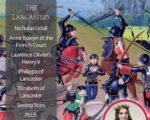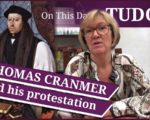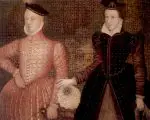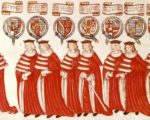
Here’s the full version of your monthly magazine: all about the house of Lancaster. The magazine is a whopping 80 pages long and it’s chock full of top articles as normal.
[Read More...]
Here’s the full version of your monthly magazine: all about the house of Lancaster. The magazine is a whopping 80 pages long and it’s chock full of top articles as normal.
[Read More...]
On this day in history, 31st March 1631, the Tudor and Stuart metaphysical poet, satirist, lawyer and clergyman John Donne died.
Donne had an amazing career, going on voyages, serving as a royal chaplain and diplomat, and writing sermons, songs, satires and poetry, including an erotic poem, “The Flea”.
Find out more about John Donne and hear some of his work in today’s talk.
[Read More...]
On this day in Tudor history, 30th March 1533, at the Passion Sunday service, Thomas Cranmer, Archdeacon of Taunton, was consecrated as Archbishop of Canterbury.
His consecration was not like those of others before him, however, because as well as making the usual oath promising to be faithful to the papacy and to denounce heretics, he also made a protestation to show that his oath would not conflict with his loyalty to King Henry VIII and his commitment to reforming the church. Hmmmm…. complicated.
[Read More...]
On this day in Tudor history, 29th March 1555, in the reign of Queen Mary I, Protestant and former Dominican priest, John Laurence, was burned at the stake for heresy in Colchester.
At his burning, young children encouraged him with their prayers.
Find out more about his John Laurence’s sad end in today’s talk.
[Read More...]
What a wonderful live chat we had last night with Tracy Borman. We were chatting about Henry VIII and his men.
[Read More...]
Let’s put the troubles of this workd to one side for a few minutes and have some fun with Tudor history.
This week’s quiz is a true or false quiz on Tudor myths, rumours and scandals. What was actually true? See if you know with this fun quiz.
Good luck!
[Read More...]
You might remember that Teasel and I did a talk on Tudor diapers (nappies) a few weeks ago and that we promised to follow that up with a talk on what Tudor babies and children wore. Well, here you go!
In today’s edition of Teasel’s Tudor Trivia, Teasel and I share our research on how Tudor mothers would dress their babies. Next time, we’ll be looking at what Tudor toddlers and children wore.
[Read More...]
This day in history, 28th March 1483, is one of the dates out forward as the birthdate of Raffaello Sanzio da Urbino, or Raphael as he is known, the Italian Renaissance artist and architect.
Did you know that Henry VII owned a piece of art by Raphael and that Henry VIII admired his work?
Find out a bit more about Raphael and see some of his beautiful works of art in today’s talk.
[Read More...]
On this day in Tudor history, 27th March 1489, the Treaty of Medina del Campo was signed between England and Spain. One part of it was the arrangement of the marriage between Arthur, Prince of Wales, and Catherine (or Catalina) of Aragon. It was signed by Spain on this day and ratified in 1490 by Henry VII.
Find out more about this treaty and the betrothal and marriages (yes, plural!) of Arthur Tudor, Prince of Wales, and Catherine of Aragon in today’s talk.
[Read More...]
Samuel Pepys’ diary has been very useful to historians because it gives a first hand account of the Restoration, the Second Anglo-Dutch War, the Great Plague and the Great Fire of London, so at the moment I’m keeping a daily diary for future historians to use as a source on the Coronavirus. Who knows if anyone will ever read it, but keeping it is also keeping me sane.
It made me think about the memoirs and diaries from the Tudor period, and just how useful they are at giving us an insight into the lives of Tudor people.
[Read More...]
On this day in history, late on 26th March 1603, two days after the death of Queen Elizabeth I, Sir Robert Carey arrived at Holyrood in Edinburgh, Scotland, to inform King James VI that Queen Elizabeth I was dead and that James was now king.
It took Carey just two days to get from London to Scotland, and he had an accident on the way, but it was all worth it. Find out about his journey and what happened in today’s “on this day in Tudor history” talk.
[Read More...]
On this day in Tudor history, 25th March 1586, Good Friday and also Lady Day, the Feast of the Annunciation, Catholic martyr Margaret Clitherow (née Middleton), known as “the Pearl of York”, was pressed to death at the toll-booth on Ouse Bridge in York, under 7 or 8 hundredweight. She was executed for harbouring Catholic priests.
[Read More...]
On this day in history, 24th March1619, Robert Rich, 1st Earl of Warwick, Tudor nobleman and politician, died at his London home, Warwick House in Holborn. He was laid to rest at Felsted Church in Essex.
Rich was an incredibly wealthy man and a good catch for Penelope Devereux, sister of the Earl of Essex, but their marriage was unhappy and she had an affair. Find out more about Rich and his marriage in today’s talk.
[Read More...]
On this day in Tudor history, 23rd March 1540, Waltham Abbey, an Augustinian house in Essex, was surrendered to the Crown. It was the last abbey to be dissolved in Henry VIII and Thomas Cromwell’s dissolution of the monasteries.
Find out more about this historic abbey, its origins and what’s left today, and also who profited from its lands, in today’s talk.
[Read More...]
On this day in Tudor history, 22nd March 1582, gunner, mathematician and writer, William Bourne was buried at Gravesend in Kent.
This popular author, who was able to explain technical matters for the common man in his books, was also a gunner, mathematician and inventor, yet he received no university education. He also drew plans for a submarine, although he never built it.
Find out more about the fascinating William Bourne and his works in today’s talk.
[Read More...]
Every day, I post “on this day in Tudor history” videos here on the Tudor Society. How much information have you actually taken in from them? Test your knowledge of March Tudor history events with this fun wordsearch, Be warned, words can go in any direction!
Click on the link or image below to open and print out.
[Read More...]
On this day in Tudor history, 21st March 1603, a dying Queen Elizabeth I finally took to her bed.
Elizabeth I had been queen since November 1558, but now she was dying. She had deep-rooted melancholy, couldn’t sleep and was refusing to eat. She spent her days lying on cushions in her withdrawing chamber. But on 21st March, she was finally persuaded to go to bed.
Find out more about these last days in this talk.
[Read More...]
On this day in Tudor history, 20th March 1544, Cuthbert Mayne (Main/Maine) or St Cuthbert Mayne, Roman Catholic priest and martyr, was baptised in Youlston in North Devon.
Cuthbert Mayne has gone down in history as the first seminary priest to be martyred. He was hanged, drawn and quartered at Launceston on 30th November 1577, in the reign of Queen Elizabeth I.
Let me tell you a bit more about this Elizabethan martyr.
[Read More...]
Here in Spain, we’ve been on lockdown since Monday due to the Coronavirus pandemic. Now, I could use this as inspiration to talk about epidemics, the plague, influenza and sweating sickness in history, but I’m not. I’ll give you links to my talks on those, but I want to stop thinking about the nasty stuff.
So, with so many people around the world in lockdown or self-isolating, I thought I’d give you some ideas for keeping occupied and getting your Tudor history fix.
[Read More...]
On this day in Tudor history, 19th March 1568, Elizabeth Seymour, Lady Cromwell, died. She was around fifty years old at her death.
Elizabeth was the sister of a queen, and a lord protector, and two of her brothers were executed as traitors, but what else do we know about Elizabeth Seymour and how is she linked to the Cromwell family and a portrait once thought to be of Queen Catherine Howard?
Find out more in today’s talk.
[Read More...]
Apologies for the short notice, but things are a bit chaotic with the lockdown here in Spain. This month’s informal live chat will be taking place this Saturday, 21st March, and the topic is The Tudors on TV and in film. We’ll be discussing TV programmes, movies, documentaries, adaptations of Tudor novels etc. and do feel free to share recommendations or pose questions to other members.
[Read More...]
On this day in Tudor history, 17th March 1565, Scottish theologian and Reformer Alexander Alesius (also known as Ales, Aless), died in either Leipzig or Edinburgh.
Alesius wrote a huge number of theological works, was friends with reformers Philip Melancthon and Thomas Cranmer, Archbishop of Canterbury, but had a row with the Bishop of London at one point.
Let me tell you a bit more about Alexander Alesius and also a terrifying vision or nightmare he experience in the early hours of 19th May 1536, the day of Queen Anne Boleyn’s execution.
[Read More...]
On this day in history, 16th March 1619, actor Richard Burbage was buried at St Leonard’s Church, Shoreditch.
Burbage was a famous actor in the reigns of Queen Elizabeth I and King James I, peforming for royalty and even being in King James’ company of players. Burbage was also a good friend of William Shakespeare, and the two men were involved in the building of the famous Globe Theatre.
Find out more about Richard Burbage, his life and career, in today’s talk.
[Read More...]
On this day in Tudor history, 15th March 1532, King Henry VIII used what was described as “foul language” to William Warham, Archbishop of Canterburyt. Henry VIII also threatened the poor man, and it is amazing that Warham kept his head as the king was furious.
What happened? Find out what Warham did to upset the king in today’s talk.
[Read More...]
Following on from this week’s Claire Chats talk on Tudor society, its hierarchy, the different classes, and the nobility in Tudor times, I thought I’d get your little grey cells working with a fun quiz on the topic. Good luck!
[Read More...]
On this day in Tudor history, 14th March 1555, courtier, envoy and landowner, Sir John Russell, 1st Earl of Bedford, died at his London residence on the Strand aged around 70.
Russell was an important Tudor man who served four Tudor monarchs – Henry VII, Henry VIII, Edward VI and Mary I – AND he managed to keep his head, dying a natural death at a good age.
Find out more about this Earl of Bedford, his life, his rise and his career at the royal court, in today’s talk.
[Read More...]
On this day in Tudor history, 13th March 1540, sixty-eight-year-old Henry Bourchier, 2nd Earl of Essex, died after suffering a broken neck in a horse-riding accident. Chronicler Charles Wriothesley recorded: “the Earl of Essex, riding a young horse, by misfortune cast him and brake his neck at his place in Essex, which was great pity.”
Henry Bourchier, 2nd Earl of Essex, was related to the royal family and served both Henry VII and Henry VIII. Find out more about this Tudor man in today’s talk.
[Read More...]
I’ve received a few questions recently about the structure of society and how the nobility worked in Tudor times, so I thought I’d do this Claire Chats talk on the topic.
[Read More...]
On this day in Tudor history, 12th March 1537, Cistercian monk William Haydock of Whalley Abbey, Lancashire, was hanged for treason at Whalley.
Haydock’s abbey had been implicated in the 1536 Pilgrimage of Grace Rebellion, so Henry VIII wanted the abbey punished. Find out more about Whalley Abbey’s part in the rebellion, how Haydock and several other monks were punished, and what exactly happened to William Haydock’s remains, in today’s talk.
[Read More...]